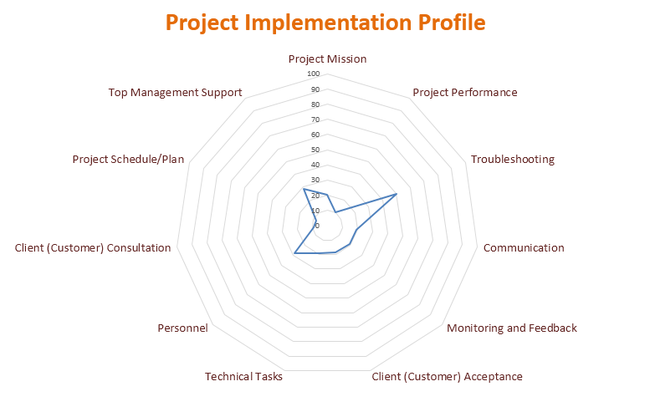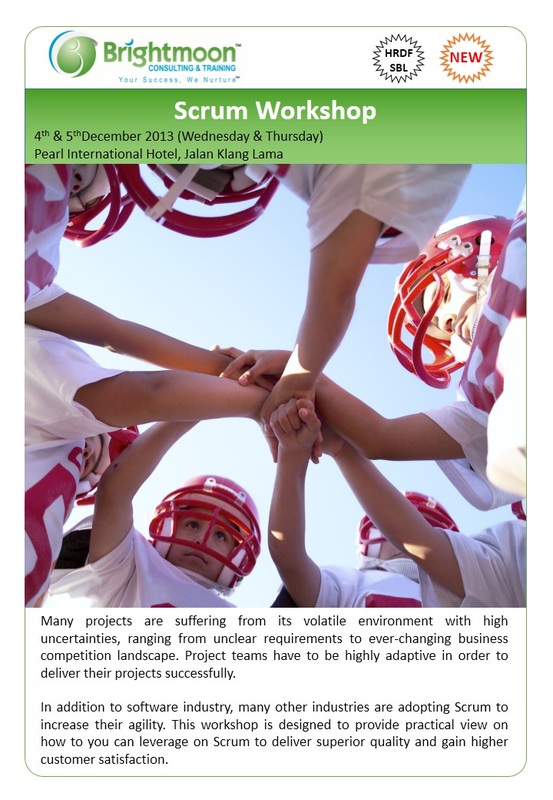|
We are delighted to bring these three pro-bono training to you. Now you can register in the links below. At the same time, stay tuned on our Eventbrite page on the news of future sessions. Wednesday, January 22, 2014 from 9:00 AM to 12:00 PM Wednesday, January 22, 2014 from 1:30 PM to 2:30 PM Wednesday, January 22, 2014 from 3:00 PM to 5:00 PM
0 Comments
 Welcome to 2014. What is your new year resolution? This blog is specially for you, if one of your goals is to make career transition to project management. This post is a personal experience sharing from Tai Choo Tack. The First Step - Not for Fainthearted The future is lucrative if he was to stay in existing role. However, he decided to conquer another peak. The very first step is to coming down from existing peak. It is like letting go all the fortunes and start from ground zero, and this is not for fainthearted! The Second Step - Search for the Bullet Since he was in employment, he started lobbying for project management opportunities within the company. At the same time, he took MBA specialized in Project Management. With hope, he has sufficient knowledge to jump-start a new role. Unfortunately, the luck was not on his side. His superior and department head unable provide such opportunities. Thus, he started to look out for new job. The Third Step - Bite the Bullet This is common step in any career change - find new job elsewhere. Five points below can give you a good start:-
Concluding Remark A quick reflection, Tai Choo Tack took 6 months to land him on a new role. He was going all-out to make the transition happen, and ready for pay-cut. What kept him moving is the analogy of two peaks - he needs to go all the way down from where he stands, before he can go to a new peak. Please comment here if you are ready to bite the bullet to venture into project management role.  Happy New Year to everyone. Our 2014 training calendar is available here. At first cut, the public training is on:-
We proudly offer pro-bono training (FREE training) covering topics below. Their availability will be published in this blog, EventBrite and Facebook.
We would love to listen to what you have in mind. Till then, have a great and wonderful 2014 ahead!  Typical project success criteria mentioned previously are on-time, on-budget and within scope. This article is to shed some light on 10 Critical Success Factors (CSF), which have empirically proven in contributing directly and indirectly to success criteria above. However, without proper measurement, it would be challenging to have these CSF serve as a reputable benchmark. The History Two renowned experts (Pinto & Slevin) conducted this research over 400 projects across industries. They came out a diagnostic instrument to measure these 10 CSF - Project Implementation Profile (PIP). This is 360-degree approach to solicit feedback from all project stakeholders. Over two decades, it has been proven on its practicality and usefulness. The Wake-up Call There was on product development project in one multinational organization. Everyone was excited about the project, including the technology partner. However, something does not feel so right, and no-one is able to tell the exact. After PIP was conducted, the shocking and ugly truth revealed itself. At the quick glance on its CSF rating (see figure below), this project is at the brink of extinction. They have been experiencing unnecessary fire fighting, chasing unreasonable deadlines and stressed working atmosphere.  The Priority of Remedial Actions With the insights of CSF rating, there is always a chance to salvage the project.
Usage of PIP
Concluding Remark The success of adopting PIP in entire organization requires openness and higher project management maturity. Without that, PIP may be wrongly used as a political weapon. An independent third party could be invited in conducting PIP to ensure all project stakeholders are comfortable in voicing their honest and brutal feedback - anonymously. This third party will compile all feedback into one CSF rating (as seen in figure above).  Towards year-end, all successful individuals/ organizations will have a reflection on how they performed in 2013. Subsequently, they can plan how to increase/ elevate their success to new height in 2014. Back to project management, the usual success statements are on-time, on-budget and within scope. These three are often used because they are easy to measure. And, this is how a project be profitable. On the flip side of this success definition:-
Critical Success Factors outlined by Pinto & Slevin provides holistic overview on project success.
All these factors are good on paper. Without proper quantification, they serve no purpose in project benchmarking. Next article we will share a way to translate qualitative inputs into numbers. Till then, have fun reflecting now. Now you can search our office location in Google Map.
 Scrum has proven its benefits in software development. These projects are having transparent communication, high adaptability, better client engagement, and many more. Thus, this create an impression that Scrum is only for software development and nothing else. Many other industries are eyeing on how to harvest such benefits of Scrum in their context. Let's take a step back - PRINCE2 was originated for IT projects, PMBoK was initially meant for construction projects Now many non-IT, non-construction industries are using them. Scrum is a Framework Virtually all industries are able adopt Scrum without having to make it industry-neutral. Scrum is a framework and not a methodology. Allow us to have quick look on their differences. Framework - it outlines the principles and generally answer "Why & How" and often challenges status quo. For examples:
Methodology - it prescribes the working mechanisms of an activity/ deliverable, i.e. "What" need to to be done by "Who" via "How" approach in the timing of "When". For example:
 Framework is for Adoption and not Adaptation As a framework, it must be accepted as a whole. Any changes on it, may invite chaos if not catastrophe. When the Scrum framework is adhered, you can come out your own working mechanism based on your preferences. Just like a house - its framework is solid foundation of everything in it, which make the occupants comfortable living in it. You can decorate it without worrying its safety. Any removal of the framework entails unexpected risks. Concluding Notes When you are planning to introduce Scrum in your team/ organization, it will be better to have someone knowledgeable in Scrum to be on your side. This is to ensure the Scrum framework is maintained and not omitted. On the other side, if your Scrum does not deliver expected benefits, you may want to consider to re-inspect its framework. Hopefully after the inspection, you can restore the framework and reap its intended benefits. Have fun decorating your Scrum framework. We are delighted to introduce this complementary half-day training to you. Seats are limited. Please register yourselves in Eventbrite to avoid disappointment. Who Should Attend?
What is PRINCE2? It is a project management methodology with worldwide recognition and adoption. Join this session to find out more. What Do I Gain? After this session, you will have higher level of appreciation/ understanding on PRINCE2. And, it can help you to plan your professional develop in the realm of Project Management. What Can an Organization Gain? You can plan how to reap the practical benefits of PRINCE2 in your Organization.  Intended Benefits of Scrum Scrum is gaining popularity due to its benefits in making a team more adaptive and responsive to its ever-changing environment, such as volatile user changes, technology advancement & etc. In the nutshell, Scrum is to make a team be self-organized. An self-organized team able to deliver results with higher customer satisfaction and better client engagement. Introducing Scrum Role More and more organizations introduce a role named Scrum Master (SM). This role is a Scrum evangelist in the organization. He/ she does not have any authority over the team and only facilitates the team to be self-organized. The first expected benefit is the team won't cause any headache to the management team, particularly in managing their works in a team. The communication within the team is open and transparent. Thus, everyone has a happier life. The Reality Back to reality, many organizations pro-claimed they are using Scrum or have roles of SM/ Product Owner (PO). However, these roles expects the team can deliver faster under the flag of Scrum, despite the fundamental working arrangements are status-quo (i.e. prior introduction of Scrum). The SM/ PO holds responsibilities of typical team lead or manager. They dictate how the team doing their works, which is contradicting to Scrum approach - make the team self-organized. Due to various reason, they refused to claim they failed in using Scrum, they said they "adapted" Scrum. "Adapted" Scrum - The Destroyer Let's have a quick reality check, whether your organization or team has "adapted" Scrum in a counter-productive way:-
Concluding Remarks Scrum is designed to make the team self-organized. Such self-organized team won't happen overnight and it takes time to nurture them. Once they are matured, an organization can harvest maximum benefits of such self-organized team. When the "adapted" Scrum unable to make your team self-organized, it must be something wrong. Take a step back and look on what you really want from Scrum. It requires change of mindset and ways of working. A proper transition plan is needed to ensure everyone (beside the team) understand how to make Scrum works. It should follow-up with a monitoring stage to ensure the organization/ team practice Scrum to its fullest. Hope you can Scrum your way to the ma Your Agility Ticket - Scrum Workshop
Please refer to attached flyer (3 images) for greater details. Who We Are Allow us to briefly introduce ourselves - Brightmoon Consulting & Training. We have combined experience of 30 years in Software Development and Project Management. We are certified with two leading Scrum advocates - ScrumAlliance and Scrum.org. Our passion is to nurture the success of others in delivering successful software projects via Scrum. In Need of Practical Knowledge in Scrum Many companies are aware that they need to be highly agile to meet market dynamics. Thus, many of them introduce scrum/ agile into their work. However, many are unable to reap much benefits of scrum. Primary factor is they don't have practical knowledge and skills to make scrum work for them. Most of the existing trainings emphasizes on certification and not much on its practicality and usage. Therefore, it inspires us to share our passion in Scrum to you. |
Categories
All
Archives
February 2015
Our Passion for YouWe are looking forward to share our passion to build your success now.
|


 RSS Feed
RSS Feed


